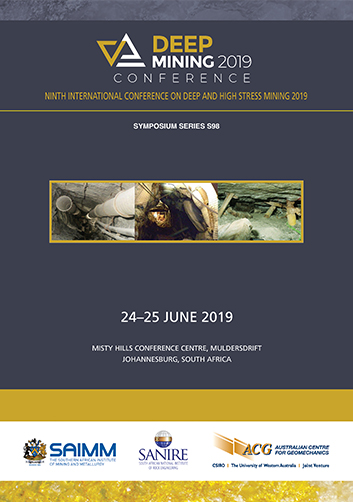Anisotropic rock mass behaviour in large deformation ground at CSA mine

|
Authors: Sharrock, GB; Chapula, B |
DOI https://doi.org/10.36487/ACG_rep/1952_23_Sharrock
Cite As:
Sharrock, GB & Chapula, B 2019, 'Anisotropic rock mass behaviour in large deformation ground at CSA mine', in W Joughin (ed.), Deep Mining 2019: Proceedings of the Ninth International Conference on Deep and High Stress Mining, The Southern African Institute of Mining and Metallurgy, Johannesburg, pp. 307-322, https://doi.org/10.36487/ACG_rep/1952_23_Sharrock
Abstract:
This paper summarises key findings from a 39-month study at CSA Mine on factors controlling anisotropic ground behaviour in sub-level open stope (SLOS) access tunnels at depths of 1500 m – 1700 m. The aim was to understand factors controlling high displacement ground behaviour through numerical and empirical back analysis at 45 damage sites over a 39-month period. It was found that excavation orientation, rock mass matrix and foliation strength, and stress path are key parameters influencing tunnel damage and convergence at CSA Mine. Tunnels driven parallel to foliation (i.e., along strike), experienced much higher levels of damage than those driven perpendicular to foliation. Drives at intermediate angles experience varying levels of damage, depending on rock mass strength and stress. The stress path induced by mining was found to significantly affect both the initiation and progression of damage in both tunnels and raises.
References:
Chapula B. and Sharifzadeh M. (2019). Strategies for managing large deformation at CSA Underground Mine. ISRM 14th International Congress of Rock Mechanics.
CMPL (2017). CMPL, CSA Mine, Ground Control Management Plan, May 2017, Author: David Dickson.
Hadjigeorgiou, J. and Karampinos, E. (2017). Design tools for squeezing ground conditions in hard rock Mines, Deep Mining 2017: Eighth International Conference on Deep and High Stress Mining – J Wesseloo (ed.), P693-706.
Hosken, J., Haren, E and Winchester, A. (2006). Resource Modelling in an Evolving Mine – CSA Mine, Cobar, New South Wales, Proceedings Sixth International Mining Geology Conference, pp. 153-166.
Lee, M., Mollison, L., Campbell, A. and Litterbach, N. (2010). Rock Stresses in the Australian Continental Tectonic Plate – Variability and Controls, 11th IAEG Congress – Geologically Active New Zealand, Auckland, September 2010.
Marinos, P. and Hoek, E. (2000). Predicting Tunnel Squeezing Problems in Weak Heterogeneous Rock Masses. Tunnels Tunnelling Intl., Part 1, November, Part 2, December.
Mercier-Langevin, F. and Hadjigeorgiou, J. (2011). ‘Towards a better understanding of squeezing potential in hard rock mines’, Mining Technology, vol. 120, no. 1, pp. 36–44.
Sandy, M.P., Gibson, W. and Gaudreau, D. (2007). ‘Canadian and Australian ground support practices in high deformation environments’, in Y Potvin, J Hadjigeorgiou & D Stacey (eds), Challenges in Deep and High Stress Mining, Australian Centre for Geomechanics, Australian Centre for Geomechanics, Perth, pp. 297–311.
Singh, B., Jethwa, J.L., Dube, A.K. and Singh, B. (1992). ‘Correlation between observed support pressure and rock mass quality’, Tunnelling and Underground Space Technology, vol. 7, no. 1, pp. 59–74.
Sharrock, G.B. and Cuello, D. (2016). Geotechnical Milestones at Mount Lyell Mine. Massmin 2016 - Seventh International Conference and Exhibition on Mass Mining.
Tavakoli, M. (1994). Underground metal mine crown pillar stability analysis – PhD Thesis, University of Wollongong.
© Copyright 2025, Australian Centre for Geomechanics (ACG), The University of Western Australia. All rights reserved.
View copyright/legal information
Please direct any queries or error reports to repository-acg@uwa.edu.au
View copyright/legal information
Please direct any queries or error reports to repository-acg@uwa.edu.au